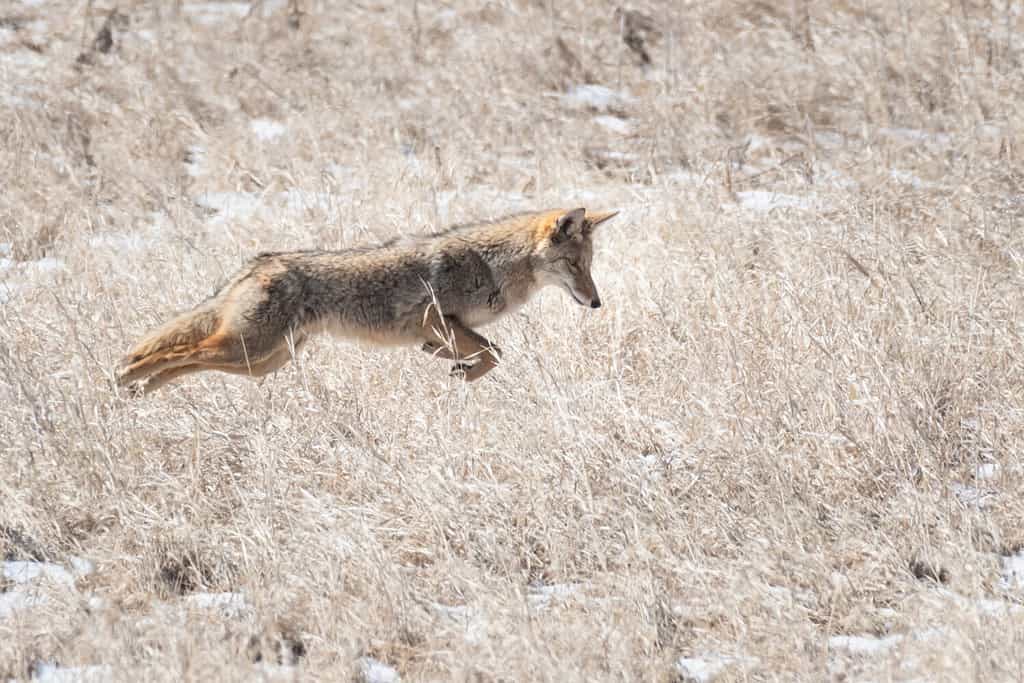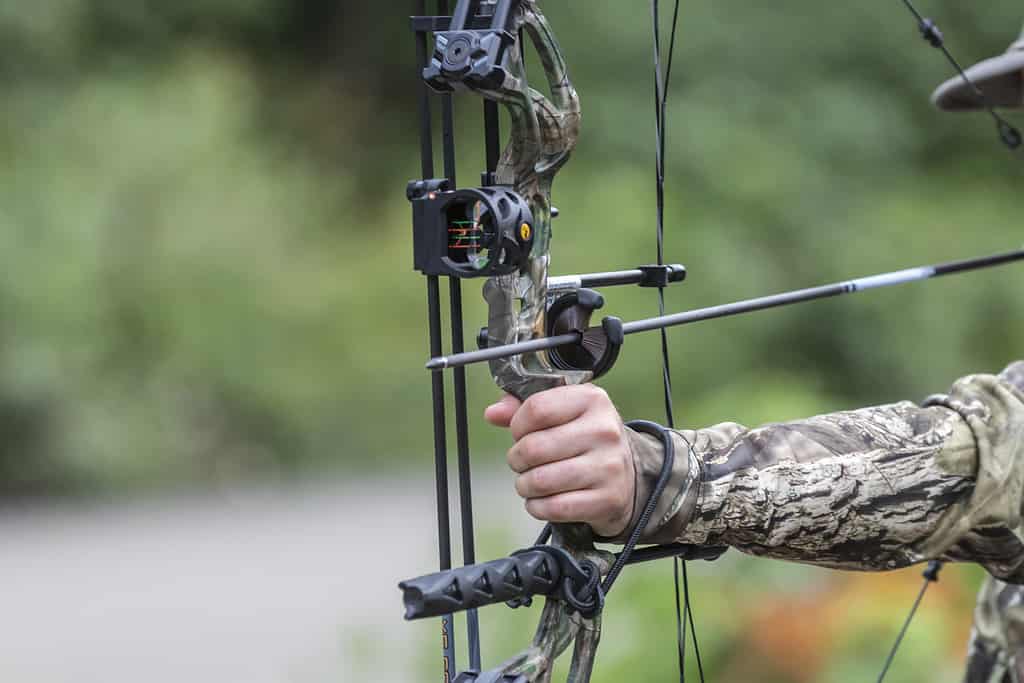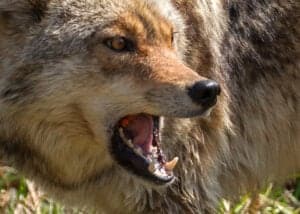There’s nothing new about coyotes in Virginia. You will find this highly social (amongst themselves) animal in every state except Hawaii. The last is just a matter of time since nearly every animal on the island state found a way there at some point or another.
According to the Virginia Department of Wildlife Resources, the coyote is a nuisance in the state, and population numbers are too high. Coyotes are finding their way into suburban areas, increasing witness reports as well. Virginia coyotes are an interesting breed, larger than their western cousins, and non-native to the state.
The animal’s DNA is a 13% match with the gray wolf and an 11% match with the eastern wolf. The rest is mostly coyote, with a 1/10 splash of domestic dog in there for good measure. The wolf side of their physicality is what gives them their larger size.
The Population Size Of Coyotes In Virginia

Coyotes can jump over fences and other structures.
©Eivor Kuchta/Shutterstock.com
The population of coyotes in Virginia is so numerous that the animals are making their way into major metropolitan and suburban areas. Witnesses spot them in Richmond from time to time, with the Virginia Department of Game and Inland Fisheries releasing information and instructional literature to educate the local populations in each county on dealing with them.
The most recent estimate, from Virginia Tech, places their numbers a shade north of 50,000 throughout the state. There are now so many of them that the USDA is recommending raising the coyote caps in certain Virginia counties. For the most part, coyotes are harmless to people directly, unless one or more of them is rabid.
However, Virginians consider them to be nuisance animals. Large and growing numbers certainly don’t help. Most people assume that coyotes are only in Virginia to control deer populations. At least, that’s the popular myth. However, the real reason is a more boring and natural tale of migration. Coyotes simply moved there and now they are thriving.
Wolves and mountain lions once ruled the rolling hills, coastal plains, Blue Ridge, and Appalachian Mountain chains of Virginia. As the area grew and more people came to Virginia, these animals moved north, opening a void for coyotes to fill—and fill they did.
Common Locations For Coyotes In Virginia
Thanks to a steady and ongoing drip of information from the Virginia Department of Wildlife Resources, we know that the coyote population in Virginia is so extensive that there is no common location. That’s because everywhere in the state is a common location.
Coyotes are wandering into the cities, and suburban areas, and are still mainstays in rural Virginia as well. There are consistent updates on dos and don’ts to keep coyotes from coming onto your property. Hunting often takes the blame for drastically reduced deer populations in certain counties. However, the reality is one of nature, with coyotes playing major roles in sudden deer population drops.
After all, deer are a natural prey for coyotes, especially these larger hybrids with plenty of wolves in their blood. With 88% of Virginia remaining rural, there are plenty of places for coyotes to go and still rarely encounter humans.
Coyotes are nocturnal and fairly skittish. Even with the large population numbers and their widespread habitat choices, coyotes are still difficult to spot. However, when you start seeing them walking down Main Street, you’re either dealing with a rabid coyote or overpopulation.
What Are The Hunting Rules For Coyotes In The State?

There are a few rules that Virginia requires anyone hunting or trapping coyotes to abide by.
©Stefan Malloch/ via Getty Images
Due to their overwhelming population numbers, there is currently an open-season policy on coyotes in Virginia. No kill permits are required, and the only thing that trappers or hunters have to worry about is safe and legal animal disposal afterward.
However, depending on where you live, local ordinances may be more or less restrictive. If coyotes are a problem on someone’s property, it’s always best to contact the county or city first. As a nuisance species, many of the restrictions on killing or trapping non-game animals (in the case of coyotes) are no longer a concern.
There are a few rules that Virginia requires anyone hunting or trapping coyotes to abide by.
- Do not feed them, as this will reduce their fear of humans
- Do not trap and relocate coyotes as the capture and relocation of wild animals in Virginia is against the law
- Foam around the mouth, erratic walking, stumbling, and aggressive behavior are signs of rabies, and you should contact your local health department immediately
- Check with your local county to determine whether a bounty exists or not
- Don’t leave food lying around outside (dog food, bird feeders, open trash, etc
- Close or seal any openings under the house or in shed or barns
- Maintain a fence for smaller pets/dogs
Most of these things are common sense, especially since the population is high enough that it necessitates the removal of the need for kill permits and an open-season policy.
The Impact Of Coyotes In Virginia
According to the USDA (U.S. Department of Agriculture, Wildlife Services Division), coyotes were responsible for killing 6,400 calves and 318 cows in 2015. That number is always decreasing and increasing, but it remains an issue.
The USDA recommended increasing the kill count from 500 to 1,000. Despite that, the original 500 threshold is rarely crossed. Coyotes aren’t the only animals causing problems throughout Virginia either. They are simply making the impact more brutal.
The red fox, beavers, raccoons, mice, rats, and shrews combine with the coyote to do a lot of damage to the agriculture industry in The Commonwealth. Mostly, the issue is with livestock. Coyotes and foxes can do a lot of damage in a short time.
Unfortunately, coyotes are not something the state is capable of relocating. They are far too entrenched, and their numbers are too extensive.
Final Thoughts
Coyotes in Virginia have been numerous and problematic in recent years. With a population of 50,000, it’s only natural for increases in coyotes and human interactions. That’s even though the state is 88% rural. For now, there is no time of the year when hunting or trapping coyotes is closed.
Virginia does not require kill permits either. The good news is, that coyotes naturally migrated to the area, so they were never artificially introduced to the region for one reason or another. While they are a prime example of nature at work, this is another example of humanity’s constant battle against the element of nature and learning to get along to go along.
The photo featured at the top of this post is © Derek R. Audette/Shutterstock.com
Thank you for reading! Have some feedback for us? Contact the AZ Animals editorial team.







